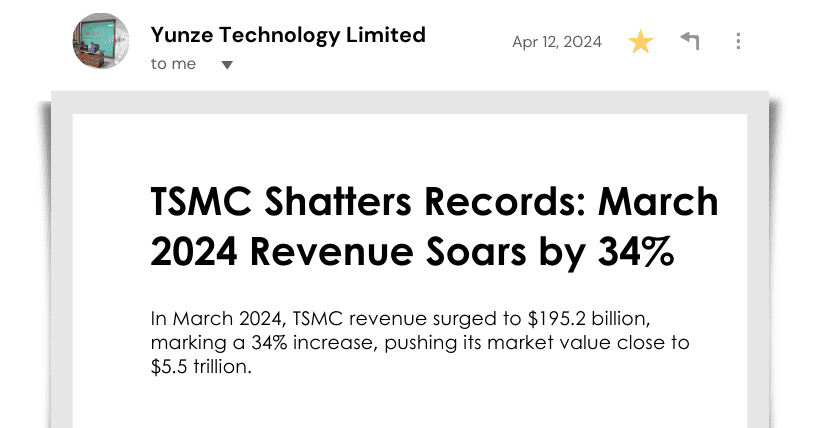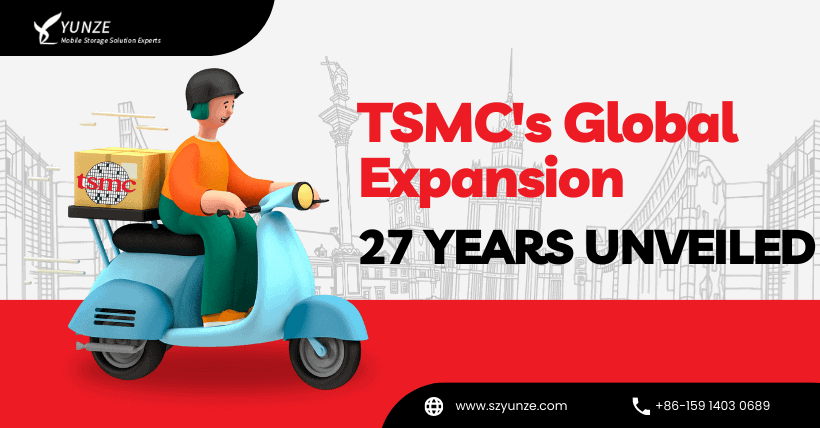Where to establish the factory? Geopolitics, supply chain resilience, and government subsidies are all factors to consider.
Under the catalyst of “geopolitical” risks, the governments of the United States, Japan, and Germany actively invite TSMC to establish factories in their countries and provide subsidies to alleviate the high costs of TSMC’s overseas construction. Currently, TSMC has confirmed the construction of wafer fabs in the United States, Japan, and Germany.
TSMC’s wafer fabs in the United States and Japan have already begun construction, with production expected to start in 2025 and 2024, respectively. The German factory is expected to start construction next year, with production scheduled for 2027.
Prior to this, TSMC’s main production bases were in Taiwan and China.
TSMC Global Manufacturing Journey Over the Past 27 Years
In 1996, TSMC, at the ‘invitation’ of the United States, established a subsidiary called WaferTech in Camas, Washington, and built an 8-inch wafer fab. This marked TSMC’s first foray beyond its home country.
In 1999, TSMC partnered with Philips Semiconductors and the Singapore Economic Development Board to jointly invest in SSMC and construct an 8-inch wafer fab in Singapore.
As China’s semiconductor industry rapidly developed, TSMC ventured into mainland China in 2003 by establishing an 8-inch fab in Songjiang, Shanghai, marking its first factory in mainland China. In 2016, TSMC announced a $3 billion investment to build a 12-inch wafer fab and design service center in Nanjing, introducing 16-nanometer technology and making it one of China’s most advanced wafer fabs at the time.
In 2020, prompted by the United States, TSMC announced the establishment of an advanced 5-nanometer wafer fab in Arizona. In December 2022, the U.S. Department of Commerce further increased its investment, adding a 3-nanometer fab and upgrading the original 5-nanometer fab to 4-nanometer technology. The investment amount surged from the initial $12 billion to $40 billion. However, due to construction delays and communication issues with local labor unions, TSMC’s U.S. fab, originally scheduled for mass production by the end of 2024, announced a postponement to 2025.
At the end of 2021, TSMC announced plans to construct a 12-inch wafer fab in Kumamoto, Japan, with process technologies of 22/28 nanometers and 12/16 nanometers. Together with Sony Semiconductor Manufacturing and Denso Corporation, they formed the Japan Advanced Semiconductor Manufacturing (JASM) company, with TSMC holding a 70% stake, Sony Semiconductor Manufacturing holding 20%, and Denso Corporation holding 10%.
TSMC’s JASM in Japan, a joint venture with Sony and Denso, not only meets the conditions for Japanese government subsidies but also positions Sony and Denso as the primary customers for the Japanese factory. Located in Kumamoto, close to Sony’s facilities, JASM not only provides proximity for supporting Sony but also allows for Sony’s assistance during the construction and operation of the factory.
Denso, originally a division of Toyota, is currently the world’s second-largest automotive components supplier. Consequently, JASM’s customer base may potentially expand to include automotive semiconductor companies in the future.
Construction of JASM began in mid-2022, with mass production expected to commence by the end of 2024. The project is currently on track as planned.
On August 8, 2023, TSMC announced its plans to establish a facility in Germany. TSMC will invest approximately 3.5 billion euros to create the “European Semiconductor Manufacturing Company” (ESMC), commonly referred to as “EuroTSMC.”
In addition to TSMC, Infineon, Bosch, and NXP will each contribute 500 million euros to invest in ESMC. TSMC will hold a 70% stake in ESMC, while Infineon, Bosch, and NXP will each hold a 10% stake.
Both ESMC and JASM are joint ventures with local customers who possess experience in Semiconductor Manufacturing and design
Compared to TSMC’s wholly-owned facility in Arizona, both ESMC in Europe and JASM in Japan have joint venture partners. For TSMC, the key advantage of a wholly-owned approach is the avoidance of potential conflicts of interest with customers and joint venture partners.
Currently, TSMC’s factory construction in Japan is proceeding smoothly and is in line with expectations, while the U.S. factory has faced delays due to various challenges. There are notable differences in work habits and attitudes between Western and Eastern cultures, and TSMC’s partnership in Germany for factory establishment is expected to provide significant assistance in future construction and operations.”
Where to establish the factory? Geopolitics, supply chain resilience, and government subsidies are all factors to consider
Looking at TSMC’s sales figures in 2022 based on the regions (calculated according to the location of customer headquarters), the United States emerges as the largest market, accounting for 66.1%. China mainland follows at 10.9%, with Taiwan, China coming in third at 9.3%. Europe stands at fourth place with 5.5%, and Japan is fifth at 5.3%. From the perspective of proximity to customers, establishing factories in the United States appears to be a rational choice.
In 2022, TSMC reported sales of approximately $3.78 billion to companies headquartered in Japan and around $3.93 billion to companies headquartered in Europe. Considering the scale of these revenues, setting up factories in Japan and Europe seems somewhat “challenging.” Behind this decision lies not only optimism about the future growth of the automotive semiconductor industry in these regions but also considerations related to geopolitical risks.
Another favorable factor is that both Japan and the European Union have offered substantial subsidies for the establishment of wafer fabs, which can significantly reduce TSMC’s construction costs. For instance, in the case of TSMC’s factory in Dresden, Germany, the German government is expected to provide up to €5 billion in subsidies. In other words, for TSMC’s €5 billion investment, it can potentially receive an equivalent amount in government subsidies, making the conditions exceptionally favorable.
In Japan, the success of TSMC’s Kumamoto factory has generated excitement, leading the Japanese government to actively encourage TSMC to establish a second factory. The establishment of “EuroTSMC” in Germany further solidifies TSMC’s presence and enhances the resilience of the semiconductor supply chain in Germany and Europe as a whole. Both the Japanese and German governments are offering substantial subsidies to TSMC, indicating significant expectations from both countries for TSMC’s contributions.
ESMC is targeting the automotive semiconductor market while also leveraging proximity to collaborate within the manufacturing ecosystem with Bosch.
ESMC plans to build a 12-inch fab with a monthly production capacity of 40,000 wafers, focusing on semiconductor applications in the automotive industry with process technologies of 22/28 nanometers and 12/16 nanometers. Infineon and NXP are leading players in the automotive semiconductor market, and Bosch serves as a Tier-1 supplier of automotive components.
Bosch has strong relationships with major automotive manufacturers and supplies automotive components. In addition to the newly established 12-inch fab, Bosch also operates 6-inch and 8-inch wafer fabs, indicating its familiarity with semiconductor manufacturing. ESMC’s facility in Dresden, Germany, allows it to benefit from Bosch’s nearby support. With the guidance of experienced leaders, ESMC’s path to establishing the fab is expected to proceed smoothly. ESMC anticipates commencing construction in the latter half of 2024, with production starting by the end of 2027.
Compared to Intel’s high-profile factory construction strategy, TSMC’s overseas expansion appears to be more cautious and deliberate
Intel is planning to construct two advanced wafer fabs in Magdeburg, Germany, with an expected investment of €30 billion. After several rounds of negotiation, the German government has agreed to provide subsidies of approximately €10 billion for Intel’s project.
Intel’s substantial investments in advanced process wafer fabs in the United States and Europe, along with its high-profile approach, may face challenges in meeting expectations.
In contrast, TSMC’s overseas factory establishment strategy appears more cautious and deliberate. While there were some challenges during the construction of the Arizona factory, with the support of its customers, TSMC is likely to achieve favorable results.
TSMC’s establishment of factories in the United States, Japan, and Germany not only addresses geopolitical challenges but also positions the company in regions known for its technological excellence. TSMC can expect positive feedback from these regions, given their prominent status in global technology.
Overall, while Intel’s approach involves high-profile investments with substantial government subsidies, TSMC’s measured and strategic approach to overseas factory expansion appears to prioritize long-term stability and success.

Recommended Reading:

*Disclaimer: This article is the original creation of the author. The content of the article represents their personal views. Our platform is sharing and discussing it and does not necessarily endorse or agree with it. If there are any objections, please contact our support team.



